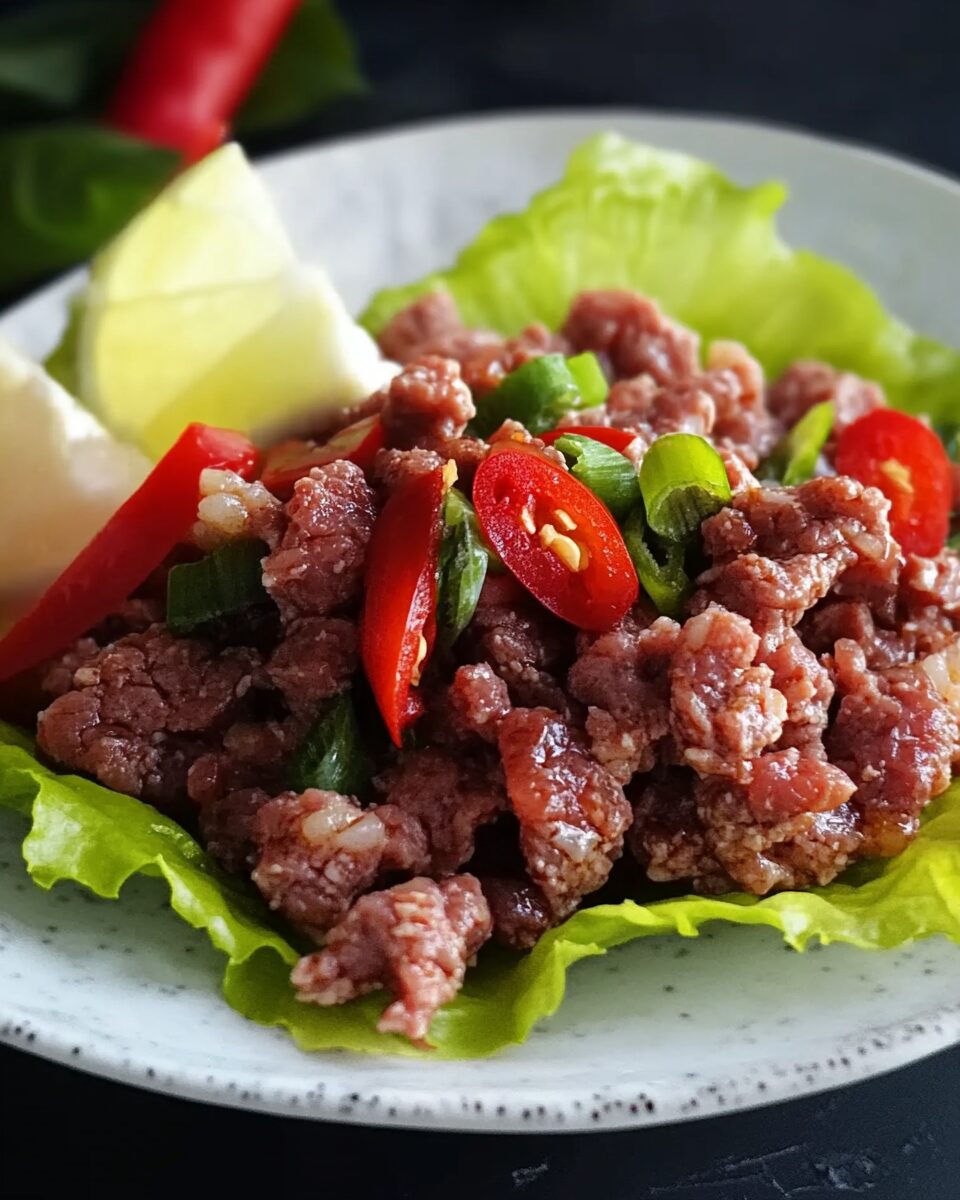Japanese Minced Beef is a flavorful and quick-to-prepare dish that combines ground beef with traditional Japanese seasonings, resulting in a savory topping perfect for steamed rice. This dish exemplifies the Japanese culinary principle of creating depth of flavor with minimal ingredients, making it both economical and delicious.
Full Recipe:
Ingredients
- Ground beef
- Freshly grated ginger
- Soy sauce
- Sake (Japanese rice wine)
- Mirin (Japanese sweet rice wine)
- Sugar
Directions
- In a skillet over medium heat, cook the ground beef until no longer pink, approximately 5 to 7 minutes.
- Add freshly grated ginger to the beef, stirring well to combine.
- Pour in soy sauce, sake, mirin, and sugar. Bring the mixture to a boil and let it cook for an additional minute to allow the flavors to meld.
Nutritional Facts (per serving)
- Calories: Approximately 200
- Total Fat: 12g
- Saturated Fat: 4g
- Cholesterol: 60mg
- Sodium: 600mg
- Total Carbohydrates: 5g
- Sugars: 4g
- Protein: 16g
The History and Cultural Significance of Japanese Minced Beef
Japanese cuisine is known for its emphasis on umami flavors, balance, and simplicity. Dishes like Japanese Minced Beef have been part of home-cooked meals for decades because they are easy to prepare and highly customizable. The word “Soboro” refers to minced or crumbled ingredients that are seasoned and cooked until slightly dry. Traditionally, this method is used not only with beef but also with chicken, pork, or even eggs.
In Japan, Soboro dishes are often prepared in advance and stored for quick meals. Families commonly serve it over rice as part of a bento (Japanese lunch box), making it a popular choice for school or work lunches. The dish is also found in “donburi” (rice bowl) meals, where the minced meat is served over a steaming bowl of rice, sometimes accompanied by vegetables or a soft-boiled egg for added texture and nutrition.
Why Japanese Minced Beef is So Popular
One of the reasons Japanese Minced Beef remains a favorite is its balance of flavors. The combination of soy sauce, mirin, sake, and sugar creates a savory-sweet taste that enhances the natural flavors of the beef. This blend of ingredients is a hallmark of Japanese cuisine, which aims to highlight the umami in every dish.
Another reason for its popularity is its versatility. Japanese Minced Beef can be used in various ways, from a simple topping for rice to a filling for lettuce wraps or even as a stuffing for onigiri (rice balls). It can also be adapted to suit different dietary needs by using ground chicken or turkey instead of beef for a leaner option.
Additionally, this dish is easy to make in large batches, making it ideal for meal prepping. Since it stores well in the refrigerator or freezer, it allows home cooks to prepare a flavorful protein in advance, ensuring that a quick and tasty meal is always within reach.
How Japanese Minced Beef Showcases Umami
Umami, often described as the “fifth taste,” is a deep, savory flavor found in many Japanese dishes. The ingredients in Japanese Minced Beef work together to enhance umami:
- Soy Sauce – A key component in Japanese cooking, soy sauce adds depth and saltiness to the dish.
- Sake – This Japanese rice wine tenderizes the beef and adds complexity to the flavor profile.
- Mirin – A slightly sweet rice wine, mirin balances the saltiness of the soy sauce and enhances umami.
- Ginger – While not traditionally classified as umami, ginger adds a refreshing sharpness that complements the rich flavors.
Together, these ingredients create a well-rounded dish that is both satisfying and delicious.
Variations of Japanese Minced Beef
While the traditional recipe is widely loved, many variations have emerged over the years, allowing home cooks to put their own spin on the dish. Some popular variations include:
- Spicy Japanese Minced Beef – Adding chili flakes, shichimi togarashi (Japanese seven-spice blend), or gochujang (Korean chili paste) creates a spicier version for those who enjoy heat.
- Garlic Butter Minced Beef – Mixing garlic and butter into the dish enhances the richness and adds a Western twist to the traditional recipe.
- Vegetable-Packed Minced Beef – Adding finely chopped carrots, mushrooms, or bell peppers increases the nutritional value and adds extra texture.
- Low-Sodium Version – Using low-sodium soy sauce or coconut aminos allows for a healthier alternative without compromising flavor.
- Egg Topped Minced Beef – Serving the dish with a soft-boiled egg or scrambled eggs adds a creamy texture and additional protein.
These variations show how adaptable Japanese Minced Beef can be while still maintaining its authentic Japanese flavors.
Serving Suggestions and Pairings
Japanese Minced Beef is incredibly versatile and pairs well with various side dishes and accompaniments. Some of the best ways to enjoy this dish include:
- Over Steamed Rice – The classic way to serve Japanese Minced Beef is over a bowl of freshly steamed white or brown rice, allowing the sauce to soak into the grains.
- With a Side of Miso Soup – A warm bowl of miso soup complements the umami flavors of the beef and creates a well-rounded Japanese meal.
- As a Topping for Noodles – Adding the minced beef to udon or soba noodles creates a hearty and satisfying dish.
- Lettuce Wraps – Wrapping the beef in crisp lettuce leaves provides a lighter, low-carb option.
- Bento Box Addition – Packing Japanese Minced Beef in a bento box alongside pickled vegetables and tamagoyaki (Japanese rolled omelet) makes for a balanced meal.
Health Benefits of Japanese Minced Beef
While this dish is flavorful and satisfying, it also offers several nutritional benefits:
- High in Protein – Ground beef provides a good source of protein, essential for muscle growth and repair.
- Rich in Iron – Beef is naturally high in iron, which supports red blood cell production and prevents anemia.
- Balanced Flavors with Minimal Ingredients – The combination of soy sauce, sake, and mirin adds rich flavor without excessive fats or artificial additives.
- Can Be Made Healthier – Using lean ground beef, reducing the sugar content, or substituting ground chicken or turkey can make the dish a lighter, healthier option.
How to Store and Reheat Japanese Minced Beef
Japanese Minced Beef is an excellent dish for meal prepping since it stores well in the refrigerator or freezer.
- Refrigeration – Store the cooked minced beef in an airtight container in the refrigerator for up to 4 days. Reheat in a pan over medium heat or microwave until warmed through.
- Freezing – Freeze the beef in portioned containers for up to 2 months. Thaw overnight in the refrigerator before reheating.
This dish’s ability to be stored and reheated easily makes it a great option for busy individuals looking for quick and delicious meals.
Conclusion
Japanese Minced Beef is a simple yet flavorful dish that showcases the beauty of Japanese home cooking. Its combination of umami-rich ingredients, ease of preparation, and versatility make it a go-to meal for many households. Whether served over rice, paired with noodles, or used as a filling for lettuce wraps, this dish is an excellent addition to any meal plan.
Beyond its delicious taste, Japanese Minced Beef also offers nutritional benefits and the flexibility to adapt to different dietary preferences. It is a perfect dish for those who appreciate Japanese flavors but want a quick and easy meal.






